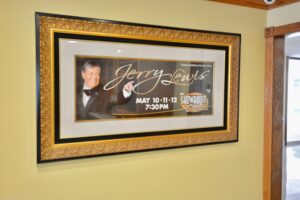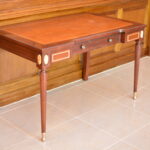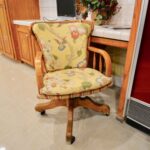

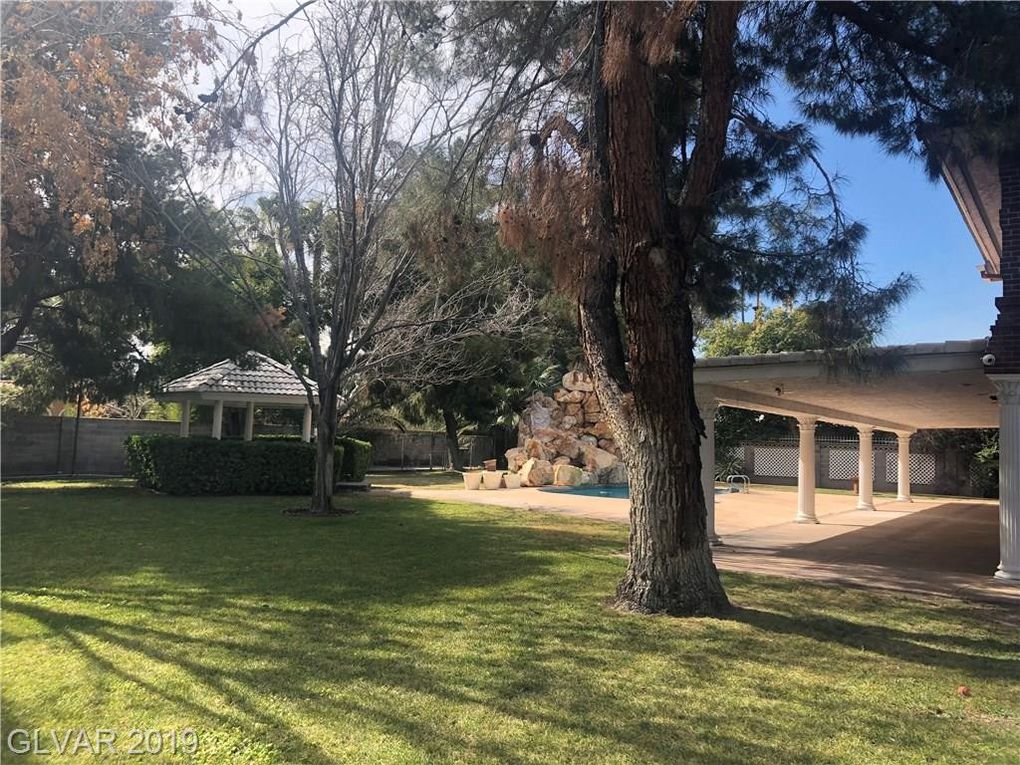








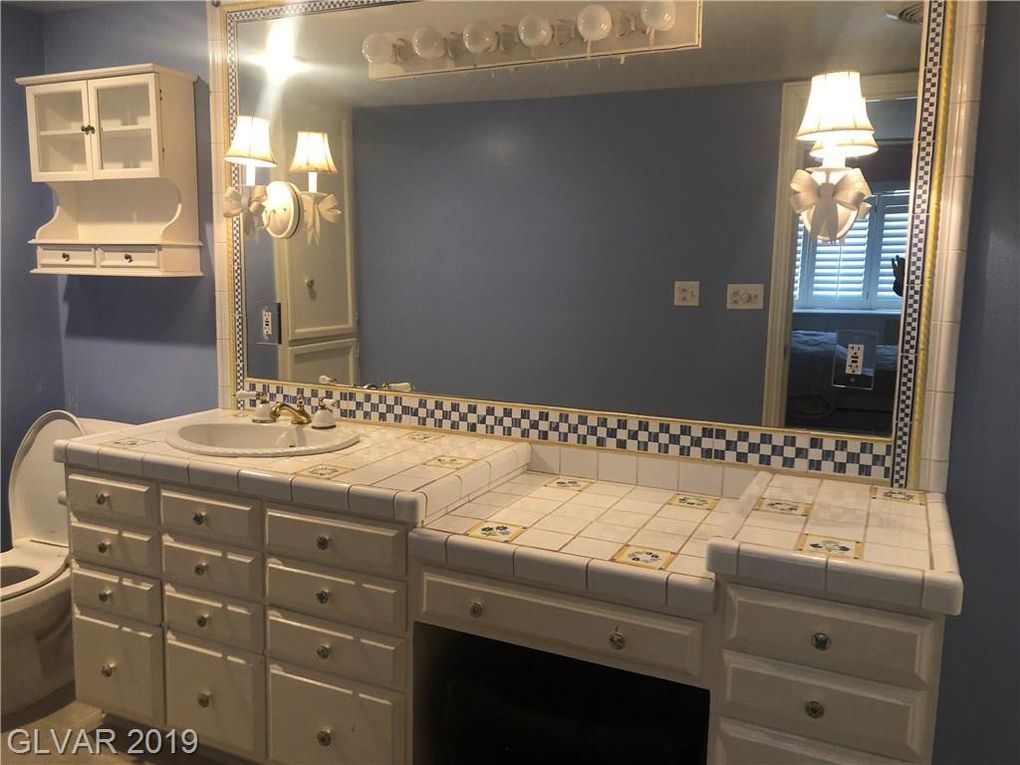

















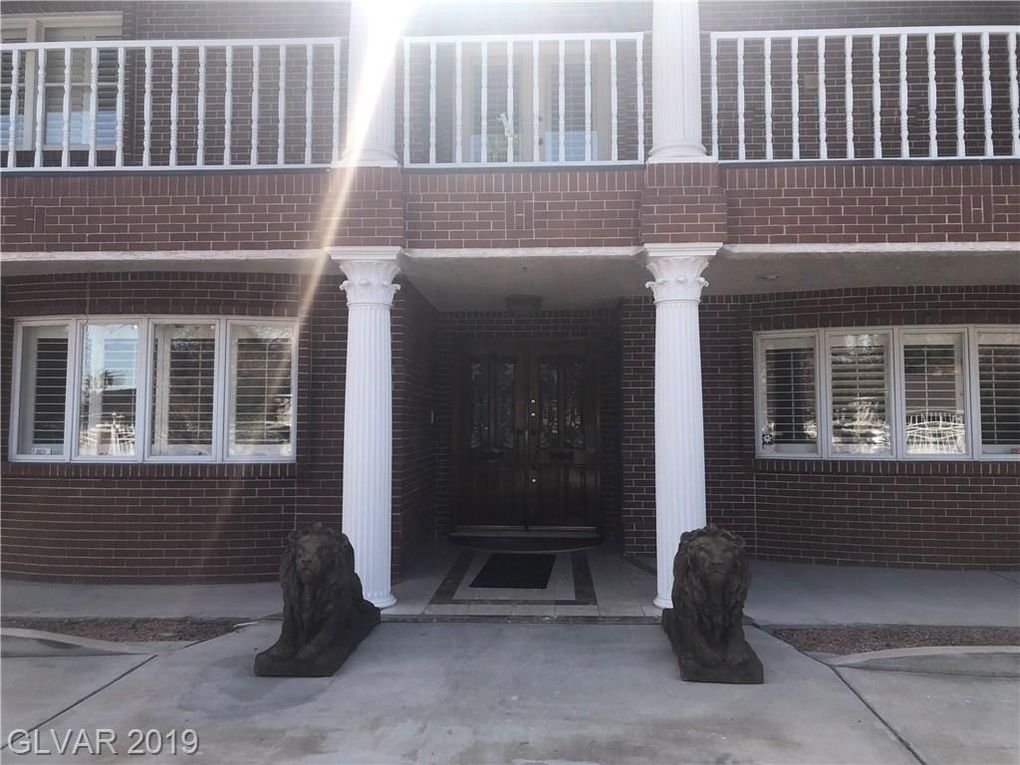







Upcoming Auction – For More Info Call (702) 659-8222
1701 WALDMAN Ave,Las Vegas, NV 89102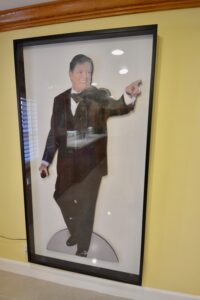
- Auction Dates
- Saturday May 25
- Sunday May 26
- Memorial Day (Monday) May 27
- O
pen House - Saturday May 18, 2pm-4pm.
- Sunday May 19, 2pm-4pm.
This is your opportunity to own Las Vegas history. For over 30 years, legendary entertainer, Jerry Lewis called this property home. With over 7000 sq ft, this magnificent property has it all! The main house has 5 bedrooms, sauna, custom petrified wood fireplace, elevator, built in bookshelves & office. Separate guest house with bedroom, bath & family room. If that custom bar  in the family room could talk! Wow! Huge pool w/ custom rock waterfall. The home will be sold on-site. PLUS CURRENT OWNERS ENTIRE CONTENTS & 2014 ROLLS ROYCE MAJORITY OF CONTENTS TO BE SOLD TO THE HIGHEST BIDDER
in the family room could talk! Wow! Huge pool w/ custom rock waterfall. The home will be sold on-site. PLUS CURRENT OWNERS ENTIRE CONTENTS & 2014 ROLLS ROYCE MAJORITY OF CONTENTS TO BE SOLD TO THE HIGHEST BIDDER
Photo Gallery: Click Here
Property Information Package PDF: Click Here
Home Inspection Report
Learn more about the life of Jerry Lewis: Click Here
Auction Ad

Jerry Lewis Biography
Joseph Levitch (March 16, 1926 – August 20, 2017), known worldwide as Jerry Lewis, was an American comedian, actor, singer, filmmaker, humanitarian and philanthropist, whose career spanned eight decades, was nicknamed “The King of Comedy” and ranked with other film stars Charlie Chaplin and Buster Keaton.
After his partnership with Dean Martin as the Martin and Lewis act, he would star in, write, produce and direct motion pictures, including The Delicate Delinquent, The Sad Sack, Rock-A-Bye Baby, The Geisha Boy, Don’t Give Up The Ship, Visit to a Small Planet, Cinderfella, The Bellboy, The Ladies’ Man, The Errand Boy, It’s Only Money, The Nutty Professor, Who’s Minding the Store?, The Patsy, The Disorderly Orderly and The Family Jewels.
Lewis appeared in concert stages, music recordings and television and outside of his career, he supported fundraising for muscular dystrophy research, while as national chairman of the Muscular Dystrophy Association and host of The Jerry Lewis MDA Labor Day Telethon every Labor Day. With worldwide box office receipts of his films in excess of $800 million, Lewis received global acclaim for his unique style with comedy and drama.
As part of a duo with Martin and as a solo performer, he was voted Hollywood’s top box-office draw from 1951 to 1965, in later years as the sole comedian.
Lewis was born on March 16, 1926, at Newark Beth Israel Hospital in Newark, New Jersey, to Russian-Jewish parents.[6] Though his birth certificate lists his name as Jerome Levitch, in his autobiography, Lewis claimed his birth name as Joseph Lewis.[7] His father, Daniel Levitch (1902–1980), born in New York, was a master of ceremonies and vaudeville entertainer[8][9][10] who used the professional name Danny Lewis.[11][12]:11 His mother, Rachel “Rae” Levitch (née Brodsky; 1903–1983) went by the stage name Rae Lewis,[12]:12 was a piano player for the radio station WOR and was her husband’s musical director. Lewis began performing at age five and would often perform alongside his parents in the Catskill Mountains in New York.[13]
He was a “character” even in his teenage years, pulling pranks in his neighborhood including sneaking into kitchens to steal fried chicken and pies. He dropped out of Irvington High School in the tenth grade. By age 15, he had developed his “Record Act” miming lyrics to songs while a phonograph played offstage. He used the professional name Joey Lewis but soon changed it to Jerry Lewis to avoid confusion with comedian Joe E. Lewis and heavyweight boxing champion Joe Louis.[12]:85 He landed a gig at a burlesque house in Buffalo, but his performance fell flat and was unable to book any more shows. Lewis worked as a soda jerk and a theater usher for Suzanne Pleshette‘s father Gene at the Paramount Theater[14][15][16][17][18] to make ends meet.
A veteran burlesque comedian, Max Coleman, who had worked with Lewis’ father years before, persuaded him to try again. Irving Kaye,[19][20][21][22] a Borscht Belt comedian, saw Lewis’ mime act at Brown’s Hotel in Loch Sheldrake, New York, the following summer, and the audience was so enthusiastic that Kaye became Lewis’ manager and guardian for Borscht Belt appearances.[23] During World War II, he was rejected for military service because of a heart murmur.[24]
Performing with Dean Martin[edit]
Lewis with Dean Martin in 1950
Lewis initially gained attention as part of a double act with singer Dean Martin, who served as straight man to Lewis’ zany antics as the Martin and Lewis comedy team. They were different from other duo acts of the time because they played to each other and had ad-libbed improvisational segments within their planned routines.
After forming in 1946, they quickly rose to national prominence, first with their popular nightclub act, then as stars of The Martin and Lewis Show on the radio NBC Red Network.[25] The two made appearances on early live television on their June 20, 1948 debut broadcast on Toast of the Town (later renamed as The Ed Sullivan Show on September 25, 1955) on CBS.[26] This was followed by guest stint on The Milton Berle Show, then appeared on NBC’s Welcome Aboard on October 3, 1948.
In 1950, Martin and Lewis signed with NBC to be one of a series of weekly rotating hosts of The Colgate Comedy Hour, a live Sunday evening broadcast. Lewis, writer for the team’s nightclub act, hired Norman Lear and Ed Simmons as regular writers for their Comedy Hour material.[27][28] Their Comedy Hour shows consisted of stand-up dialogue, song and dance from their nightclub act and movies, backed by Dick Stabile‘s big band, slapstick and satirical sketch comedy, Martin’s solo songs, and Lewis’ solo pantomimes or physical numbers.
Martin and Lewis often broke character, ad-libbing and breaking the fourth wall. While not completely capturing the orchestrated mayhem of their nightclub act, the Comedy Hour displayed charismatic energy between the team and established their popularity nationwide. By 1951, with an appearance at the Paramount Theater, they were a cultural phenomenon, attracting crowds rivaled only by Frank Sinatra earlier and later by Elvis Presley and The Beatles. The duo began their film careers at Paramount Pictures as ensemble players, first in My Friend Irma (1949), based on the radio series of the same name, and then its sequel My Friend Irma Goes West (1950).
Soon after, Martin and Lewis starred in their own vehicles in 14 more movies, At War with the Army (1950), That’s My Boy (1951), Sailor Beware (1952), Jumping Jacks(1952), The Stooge (1952), Scared Stiff (1953), The Caddy (1953), Money from Home (1953), Living It Up (1954), 3 Ring Circus (1954), You’re Never Too Young (1955), Artists and Models (1955), Pardners (1956) and Hollywood or Bust (1956). All 16 films were produced by Hal B. Wallis.
They also starred as cameos in Bing Crosby and Bob Hope‘s film Road to Bali (1952). Hope and Crosby would do the same in Lewis and Martin’s Scared Stiff a year later. Attesting to the duo’s popularity, DC Comics published The Adventures of Dean Martin and Jerry Lewis from 1952 to 1957. In 1954, the team appeared on episode 191 of What’s My Line? as mystery guests, appeared on the 27th annual Academy Awards in 1955 and then appeared on The Steve Allen Show and The Today Show in 1956.
The Martin and Lewis films were reliable financial successes for Paramount, and hugely popular with audiences. In later years, both Lewis and Martin admitted frustration, and were critical of Wallis for his formulaic and trite film choices, restricting them to narrow, repetitive roles. As Martin’s roles in their films became less important over time, Lewis receiving the majority of critical acclaim, the partnership came under strain.
Martin’s participation became an embarrassment in 1954 when Look magazine published a publicity photo of the team for the magazine cover but cropped Martin out.[29] The partnership ended with their final nightclub act on July 24, 1956 (the team’s 10th anniversary of their debut as a duo). Both Martin and Lewis went on to highly successful solo careers, and neither would comment on the split nor consider a reunion. However, they would occasionally be seen at the same public events.
Going solo[edit]
Late 1950s[edit]
After his partnership with Martin ended in 1956, Lewis and his wife Patty took a vacation in Las Vegas to consider the direction of his career. He felt his life was in a crisis state: “I was unable to put one foot in front of the other with any confidence. I was completely unnerved to be alone”.[24] While there, he received an urgent request from his friend Sid Luft, who was Judy Garland‘s husband and manager, saying that she couldn’t perform that night in Las Vegas because of strep throat,[24] and asking Lewis to fill in.
Lewis had not sung alone on stage since he was five years old, twenty-five years before, but he appeared before the audience of a thousand nonetheless, delivering jokes and clowning with the audience while Garland sat off-stage, watching. He then sang a rendition of a song he’d learned as a child, “Rock-a-Bye Your Baby with a Dixie Melody” along with “Come Rain or Come Shine.” Lewis recalled, “When I was done, the place exploded. I walked off the stage knowing I could make it on my own”.[24]
At his wife’s pleading, Lewis used his own money to record the songs on a single.[30] Record company Decca Records heard it, liked it and insisted he record an album for them.[31] The single of Rock-a-Bye Your Baby went to #10 and the album Jerry Lewis Just Sings went to #3 on the Billboard charts, staying near the top for four months and selling a million and a half copies.[24][32]
With the success of that album he recorded the additional albums More Jerry Lewis (an EP of songs from this release was released as Somebody Loves Me), and Jerry Lewis Sings Big Songs For Little People (later reissued with fewer tracks as Jerry Lewis Sings For Children). Non-album singles were released, and It All Depends On You, hit the charts in April and May 1957, but peaked at only #68. Further singles were recorded and released by Lewis into the mid-1960s.
But these were not Lewis’s first foray into recording, nor his first appearance on the hit charts. During his partnership with Martin, they made several recordings together, charting at #22 in 1948 with the 1920s chestnut That Certain Party and later mostly re-recording songs highlighted in their films. Also during the time of their partnership, but without Martin, he recorded numerous novelty-comedy numbers for adults as well as records specifically intended for the children’s market.
Having proven he could sing and do live shows, he began performing regularly at the Sands Hotel and Casino in Las Vegas, beginning in late 1956, which marked a turning point in his life and career. The Sands signed him for five years, to perform six weeks each year and paid him the same amount they had paid Martin and Lewis as a team.[31]The critics gave him positive reviews: “Jerry was wonderful. He has proved that he can be a success by himself,” wrote one.[31] He continued with club performances in Miami, New York, Chicago and Washington.
Such live performances became a staple of his career and over the years he performed at casinos, theaters and state fairs coast-to-coast. In February 1957, he followed Garland at the Palace Theater in New York and Martin called on the phone during this period to wish him the best of luck.[31] “I’ve never been happier,” said Lewis. “I have peace of mind for the first time.”[31] Lewis established himself as a solo act on TV starting with the first of six appearances on What’s My Line? from 1956 to 1966.
He guest appeared on both Tonight Starring Jack Paar and The Ed Sullivan Show and beginning in January 1957, in a number of solo TV specials for NBC. He starred in his adaptation of “The Jazz Singer” for Startime. Lewis hosted the Academy Awards three times, in 1956, 1957 and the 31st Academy Awards in 1959, which ran twenty minutes short, forcing Lewis to improvise to fill time.[33] DC Comics, switching from Martin and Lewis, published a new comic book series titled The Adventures of Jerry Lewis, running from 1957 to 1971.
Lewis remained at Paramount and became a comedy star in his own right and his first solo movie was The Delicate Delinquent (1957), marking Lewis’ debut as film producer and screenwriter. It originally had been planned as the next Martin and Lewis film. He and Martin had made two films with director Frank Tashlin, whose background as a Looney Tunes cartoon director suited Lewis’ brand of humor. After starring in The Sad Sack (1957), Lewis made more films with Tashlin starting with Rock-A-Bye Baby (1958) and The Geisha Boy (1958).
Occasionally twice since the break up, Martin invited Lewis on stage in 1958 and 1961 but the split was seriously realized. Lewis starred in Don’t Give Up The Ship (1959) and Li’l Abner (1959). After his contract with Wallis ended, Lewis had several movies under his belt and was eager to flex his creative muscle. He was free to deepen his comedy with pathos, believing, “Funny without pathos is a pie in the face. And a pie in the face is funny, but I wanted more.” In 1959, a contract between Paramount and Jerry Lewis Productions was signed specifying a payment of $10 million plus 60% of the profits for 14 films over seven years.[34]
This contract made Lewis the highest paid individual Hollywood talent to date and was unprecedented in that he had unlimited creative control, including final cut and the return of film rights after 30 years. Lewis’ clout and box office were so strong that Barney Balaban, head of production at Paramount at that time, told the press, “If Jerry wants to burn down the studio I’ll give him the match!”[35]
1960s and emergence as director[edit]
He had finished his film contract with Wallis with Visit to a Small Planet (1960) and wrapped up production on his own film Cinderfella(1960), directed by Tashlin. The movie was postponed for a Christmas 1960 release. Paramount Pictures, needing a quickie motion picture for its summer 1960 schedule, held Lewis to his contract to produce one.[36] As a result, he made his debut as film director of and starred in The Bellboy (1960).
Using the Fontainebleau Hotel in Miami as his setting — on a small budget, with a very tight shooting schedule — Lewis shot the film during the day and performed at the hotel in the evenings.[36] Bill Richmond collaborated with him on many of the sight gags. Lewis later revealed that Paramount was not happy about financing a “silent movie” and withdrew backing. Lewis used his own funds to cover the movie’s $950,000 budget.
Lewis followed “The Bellboy” by directing several more movies he co-wrote with Richmond, including The Ladies Man (1961), where Lewis constructed a three-story dollhouse-like set spanning two sound stages. The set was equipped with state of the art lighting and sound, eliminating the need for boom mics in each room.
His next feature The Errand Boy (1961), was one of the earliest films about moviemaking, utilizing all of Paramount’s backlot and offices. Lewis then starred in his first special in three years The Wacky World of Jerry Lewis. He appeared in an episode of Celebrity Golf followed by a guest spot on an episode of The Garry Moore Show. He then starred in Tashlin’s It’s Only Money (1962).
Lewis took on as guest host on The Tonight Show during the transition from Jack Paar to Johnny Carson in 1962. His appearance on the show scored the highest ratings thus far in late night, surpassing other guest hosts and Paar. The three major networks began a bidding war, wooing Lewis for his own talk show, which debuted the following year. Lewis then directed, co-wrote and starred in the smash hit The Nutty Professor (1963) with Stella Stevens.
A parody of Dr. Jekyll and Mr. Hyde, it featured him as a socially awkward professor inventing a serum that turns him into a handsome but obnoxious ladies man. It is largely considered to be Lewis’ finest and most memorable film and in 2004, it was selected for preservation in the U.S. National Film Registry by the Library of Congress as being “culturally, historically, or aesthetically significant”. Lewis then appeared in a cameo role in Stanley Kramer‘s comedy epic It’s a Mad, Mad, Mad, Mad World (1963).
He starred next in Tashlin’s Who’s Minding the Store? (1963) and then hosted The Jerry Lewis Show, a 13-week lavish, big-budget show for ABC, that aired from September to December in 1963. The show suffered in the ratings, beleaguered by technical and other difficulties, including the assassination of President John F. Kennedy, which left the country in a somber mood. Lewis co-wrote and starred in The Patsy (1964), his satire about the Hollywood star-making industry.
His last film collaboration with Tashlin was The Disorderly Orderly (1964), in which Lewis served as executive producer of. After that, Lewis then directed, co-wrote and appeared in The Family Jewels (1965) about a young heiress who must choose among six uncles, one of whom is up to no good and out to harm the girl’s beloved bodyguard who practically raised her. Lewis played all six uncles and the bodyguard.[37] This Diamond Ring, a song sung by Lewis’ son Gary Lewis and his band was featured in the film.
In 1965, Lewis was interviewed on The David Susskind Show. Lewis’ last film for Paramount Boeing Boeing (1965), co-starred him with Tony Curtis‘s lead and is based on the French stage play.[38] He received a Golden Globe nomination for this role. Lewis directed and appeared on an episode of Ben Casey, an early dramatic role. He also appeared on The Andy Williams Show, and Hullabaloo with his son Gary Lewis. In 1966, Paramount changed ownership and the new executives declined to renew Lewis’ 1959 profit sharing contract[citation needed] and after 16 years, Lewis left Paramount.
Lewis went on to make and star in Three on a Couch (1966) for Columbia Pictures. He appeared on The Merv Griffin Show alongside Richard Pryor. Lewis starred in Way…Way Out (1966), appeared on The Sammy Davis Jr. Show, then had cameos in Batman, Laugh In, was a panelist on Password and in a pilot for Sheriff Who. Lewis returned with a new version of The Jerry Lewis Show, this time as a one-hour variety show for NBC, which ran from 1967 to 1969.[39] He would next direct and star in The Big Mouth (1967) and starred on Run For Your Life.
Lewis made an appearance on The Danny Thomas Hour, starred in the Jerry Paris film Don’t Raise the Bridge, Lower the River (1968) and then appear as a guest on Playboy After Dark, surprising friend Sammy Davis Jr. in 1968. Lewis went on to star in and produce Hook, Line & Sinker (1969) and afterwards, guest starred in an episode of Jimmy Durante Presents the Lennon Sisters Hour.
1970s[edit]
In 1970, Lewis guest appeared on The Red Skelton Show, then contributed to some scripts for Filmation‘s animated show Will the Real Jerry Lewis Please Sit Down. He later guest hosted The Mike Douglas Show and then directed an episode of The Bold Ones. He made guest appearances on The Hollywood Palace, The Engelbert Humperdinck Show, The Irv Kupcinet Show, The Linkletter Show, The Real Tom Kennedy Show and A Christmas Night with the Stars.
Lewis then directed and made his first offscreen voice performance as a bandleader in One More Time (1970), a sequel to the 1968 film Salt and Pepper, at times turning stars Peter Lawford and Davis Jr. into something of an erstwhile faux Martin and Lewis. His next film was Which Way to the Front? (1970) and then guest star on The Carol Burnett Show, The Rolf Harris Show and The Kraft Music Hall in 1971.
Lewis then directed and starred in the partly unreleased The Day the Clown Cried (1972), a drama set in a Nazi concentration camp. Lewis rarely discussed the film, but stated litigation over post-production finances and copyright prevented the film’s completion and theatrical release. During his book tour for Dean and Me he also said a factor for the film’s burial was that he was not proud of the effort.
Lewis explained his reason for choosing the project and the emotional difficulty of the subject matter in an interview with an Australian documentary film crew.[40] A 31-minute version was shown on the German television station ARD, in the documentary Der Clown. It was later put on DVD and shown at Deutsches Filminstitute
Within historical context, the movie was the earliest attempt by an American motion picture director to address the subject of The Holocaust, preceding by thirteen years Claude Lanzmann‘s groundbreaking film Shoah,[41] and more than twenty years, Steven Spielberg‘s Schindler’s List and Life is Beautiful, dealing with similar themes. Significant speculation continues to surround the film. Following this, Lewis would take a break from the movie business for several years.
In 1973, Lewis was a guest on The Dick Cavett Show and NBC Follies. He then appeared on Celebrity Sportsman in 1974. Next, Lewis appeared as guest on both Cher and Dinah! in 1975. Lewis then guested on an episode of Tony Orlando and Dawn. In September 1976, Sinatra shocked Lewis by bringing Dean Martin on stage during the 11th annual Jerry Lewis MDA Telethon.
As Martin and Lewis embraced, the audience cheered and the phones lit up, resulting in one of the telethon’s most profitable years. Lewis reported the event was one of the three most memorable of his life. Lewis quipped, “So, you working?”, which he stated was a call-back to a remark he’d made to Martin when they first met. Martin, playing drunk, replied that he was “at the Meggum” (meaning the MGM Grand). The reunion made international headlines and is considered one of the most iconic moments in TV history.[42]
Less well known, Lewis returned the surprise the following year by walking onto the Aladdin stage in Las Vegas during Martin and Sinatra’s performance. They exchanged jokes for several minutes.[43] Lewis then starred in a revival of Hellzapoppin with co-star Lynn Redgrave, but it closed on the road before reaching Broadway.[44] In 1979, he served as guest host and ringmaster of Circus of the Stars.
Later years[edit]
After 11 years of absence, Lewis returned to the big screen in Hardly Working (1981), which he directed and starred in. Despite being panned by critics, it eventually earned $50 million. In 1982, Lewis was a guest on Late Night with David Letterman. In 1983, Lewis co-starred in Martin Scorsese‘s film The King of Comedy, as a late-night TV host, plagued by two obsessive fans, played by Robert De Niro and Sandra Bernhard. He received wide critical acclaim and a BAFTA nomination for this serious dramatic role.
Lewis guest hosted Saturday Night Live and also starred in Cracking Up a.k.a. Smorgasbord (1983) and Slapstick (Of Another Kind) (1984), then starred in two French films, To Catch a Cop a.k.a. The Defective Detective (1984) and How Did You Get In? We Didn’t See You Leave(1984), both of which their distribution are under Lewis’ control and stated that they would never be released in American movie theaters and on home media.
He then hosted a syndicated talk show for Metromedia, which was not continued beyond the scheduled five shows. In 1985, Lewis directed an episode of the Showtime series Brothers. In 1986, Lewis appeared at the first Comic Relief, where he was the only performer to receive a standing ovation and after that, he was interviewed on Classic Treasures. Lewis also starred in the ABC televised movie Fight For Life (1987).
In 1987, 31 years after his first double act with Martin, Lewis performed in Las Vegas with Davis Jr. That same year, he also learned of the death of Martin’s son Dean Paul Martin and attended the funeral, which lead to a more substantial reconciliation with Martin. In 1988, Lewis hosted America’s All-Time Favorite Movies, then was interviewed by Howard Cosell on Speaking of Everything. He then starred in five episodes of the CBS program Wiseguy.
The filming schedule of the show forced Lewis to miss the Museum of the Moving Image‘s opening with a retrospective of his work. In 1989, Lewis joined Martin on stage, for what would be Martin’s final live performance, at Bally’s Hotel and Casino in Las Vegas. Lewis wheeled out a cake on Martin’s 72nd birthday, sang “Happy Birthday” to him and joked, “Why we broke up, I’ll never know”.[45] Again, their appearance together made headlines. He then appeared in Cookie (1989).
Lewis at Joseph Meyerhoff Symphony Hall
In 1991, Lewis guest starred in and directed an episode of the FOX series Good Grief. In 1992, Lewis had a cameo in Mr. Saturday Night(1992), appeared as a guest on The Arsenio Hall Show, The Whoopi Goldberg Show and was interviewed by Alan King on Inside The Comedy Mind. Lewis produced a three-part retrospective for The Disney Channel entitled Martin & Lewis: Their Golden Age of Comedy, using previously unseen kinescopes from his personal archive, highlighting his years as part of a team with Martin and as a soloist.
In 1993, he was the first of a series of ‘classic’ comedians to guest star in Mad About You, playing an eccentric billionaire. He appearanced on Larry King Live and co-starred in the film Arizona Dream (1993) as a car salesman uncle to Johnny Depp‘s character as his nephew. Lewis then starred as the ‘Comedy Legend’ father of a young comic, played by Oliver Platt, in Funny Bones (1995).
Lewis’ role serves as the metaphorical pivot in 20th Century comedy, from slapstick anarchists to clever storytellers.[46] Both Arizona Dreamand Funny Bones were tongue-in-cheek roles for independent films. In 1995, realizing a lifelong ambition, Lewis made his Broadway debut, as a replacement cast member, in a revival of Damn Yankees.[47] Playing the devil, he was reportedly paid the highest sum in Broadway history at the time.[48]
He performed in both the national and London runs of the musical. Lewis missed three performances of the live show in four-plus years, one being Martin’s funeral. He was then interviewed by James Lipton on Inside the Actors Studio. In 1996, Lewis served as executive producer of The Nutty Professor remake, starring Eddie Murphy. Lewis would next appear on the 12th annual American Comedy Awards in 1998.
In 2000, Lewis appeared as a guest on The Martin Short Show, then on Russell Gilbert Live and executive produced The Nutty Professor II: The Klumps. In 2003, Lewis did guest appearances on Your World with Neil Cavuto and in a Treehouse of Horror episode of The Simpsons as guest voice Professor Frink‘s dad. He then made a cameo in Miss Cast Away and the Island Girls in 2004. In 2005, Lewis went on make guest appearances on Late Night with Conan O’ Brien and Live with Kelly.
In 2006, He guest starred in an episode of Law & Order: Special Victims Unit as Munch‘s uncle. Lewis sang and recorded the duet song “Time After Time” with Dean Martin’s daughter, Deana Martin, for her album Memories Are Made of This. He then appeared on the 81st Academy Awards in 2009.
Lewis at the Cannes Film Festival in 2013
Lewis made a musical theatre play of The Nutty Professor[49][50] at the Tennessee Performing Arts Center in Nashville in 2012. In Brazil, Lewis appeared in Till Luck Do Us Part 2 (2013), a sequel to the 2012 film Till Luck Do Us Part. In 2014, Lewis was guest on The Talk and on The Tonight Show Starring Jimmy Fallon. In 2015, Raymond Arroyo interviewed Lewis on World Over.
Lewis starred in a small role in The Trust (2016) and a serious lead role in his final film Max Rose (2016), which premiered at the Cannes Film Festival.[51] He was a guest on WTF with Marc Maron and in December, expressed interest in another movie.[52] Lewis’ last appearance was in an episode of Comedians in Cars Getting Coffee.
Lewis’ motion picture star on the Hollywood Walk of Fame at 6821 Hollywood Blvd.
- 1952 – Photoplay Award
- 1952 – Primetime Emmy Award Nomination for Best Comedian or Comedienne
- 1954 – Most Cooperative Actor, Golden Apple Award
- 1960 – Two stars (one for film and one for television) on the Hollywood Walk of Fame
- 1965 – Golden Laurel, Special Award – Family Comedy King
- 1966 – Golden Light Technical Achievement Award for his ‘video assist’
- 1966 – Golden Globe Nomination for Best Actor in a Comedy or Musical
- 1970 – Jerry Lewis Award for Outstanding achievement in being a “Person” and “Performer” for Which Way to the Front
- 1970 – The Michael S. McLean Happy Birthday and Thank You Award for Which Way to the Front
- 1977 – Nominated for a Nobel Peace Prize, for his work on behalf of the Muscular Dystrophy Association
- 1978 – Greatest Public Service Benefiting the Disadvantaged, a Jefferson Awards annual award.[198]
- 1983 – British Academy Film Awards (BAFTA) nomination for Best Actor in a Supporting Role for The King of Comedy
- 1984 – Chevalier, Ordre national de la Légion d’honneur, France
- 1991 – Comic Life Achievement Award
- 1991 – Induction into the Broadcast Hall of Fame
- 1992 – Induction into the International Humor Hall of Fame
- 1995 – Theatre World Award, for Outstanding Broadway Debut for Damn Yankees
- 1997 – American Comedy Awards Lifetime Achievement Award
- 1999 – Golden Lion Honorary Award
- 2004 – Los Angeles Film Critics Association‘s Career Achievement Award
- 2005 – Primetime Emmy Governor’s Award[199]
- 2005 – Goldene Kamera Honorary Award[200]
- 2006 – Satellite Award for Outstanding Guest Star on Law and Order SVU
- 2006 – Commandeur, Ordre national de la Légion d’honneur, France[201]
- 2009 – Induction into the New Jersey Hall of Fame
- 2009 – Jean Hersholt Humanitarian Award at the 81st Academy Awards[202]
- 2009 – International Press Academy‘s Nikola Tesla Award in recognition of visionary achievements in filmmaking technology for his “video assist.”
- 2010 – Chapman University Honorary Doctorate of Humane Letters during the 2010 MDA Telethon[203]
- 2011 – Ellis Island Medal of Honor
- 2013 – Homage from the Cannes Film Festival, with the screening of Lewis’ latest film Max Rose[65]
- 2013 – Honorary Member of the Order of Australia (AM), for service to the Muscular Dystrophy Foundation of Australia and those affected by the disorder[204]
- 2014 – “Forecourt to the Stars” imprints at Grauman’s Chinese Theatre in Hollywood[205][206]
- 2014 – New York Friars Club renames clubhouse building The Jerry Lewis Monastery[207]
- 2015 – Casino Entertainment Legend Award[208]
- 2019 – 60-foot bobblehead statue of Lewis to be erected by late spring at Lincoln Harbor Park in Weehawken, New Jersey
Martin and Lewis in film[edit]
| Year | Film | Lewis role | Notes |
|---|---|---|---|
| 1949 | My Friend Irma | Seymour | |
| 1950 | My Friend Irma Goes West | Seymour | |
| 1950 | At War with the Army | PFC Alvin Korwin | |
| 1951 | That’s My Boy | ‘Junior’ Jackson | |
| 1952 | Sailor Beware | Melvin Jones | |
| 1952 | Jumping Jacks | Hap Smith | |
| 1952 | Road to Bali | ‘Woman’ in Lala’s Dream | Cameo |
| 1952 | The Stooge | Theodore Rogers | Also uncredited writer |
| 1953 | Scared Stiff | Myron Mertz | |
| 1953 | The Caddy | Harvey Miller, Jr. | |
| 1953 | Money from Home | Virgil Yokum | |
| 1954 | Living It Up | Homer Flagg | |
| 1954 | 3 Ring Circus | Jerome F. Hotchkiss | |
| 1955 | You’re Never Too Young | Wilbur Hoolick | |
| 1955 | Artists and Models | Eugene Fullstack | |
| 1956 | Pardners | Wade Kingsley Sr/Wade Kingsley Jr. | |
| 1956 | Hollywood or Bust | Malcolm Smith |
Jerry Lewis in film[edit]
| Year | Film | Role | Notes |
|---|---|---|---|
| 1957 | The Delicate Delinquent | Sidney L. Pythias | Also producer |
| 1957 | The Sad Sack | Private Meredith Bixby | |
| 1958 | Rock-A-Bye Baby | Clayton Poole | Also producer |
| 1958 | The Geisha Boy | Gilbert Wooley | Also producer |
| 1959 | Don’t Give Up the Ship | John Paul Steckler I, IV, and VII | |
| 1959 | Li’l Abner | Itchy McRabbit | Cameo |
| 1960 | Visit to a Small Planet | Kreton | |
| 1960 | The Bellboy | Stanley / Himself | Also director, writer and producer |
| 1960 | Cinderfella | Cinderfella | Also producer |
| 1961 | The Ladies Man | Herbert H. Heebert / Mama Heebert | Also director, writer and producer |
| 1961 | The Errand Boy | Morty S. Tashman | Also director and writer |
| 1962 | It’s Only Money | Lester March | |
| 1963 | The Nutty Professor | Professor Julius Kelp / Buddy Love / Baby Kelp | Also director and writer. Selected for preservation in the United States National Film Registry by the Library of Congress as being “culturally, historically, or aesthetically significant”. |
| 1963 | It’s a Mad, Mad, Mad, Mad World | Man Who Runs Over Hat | Cameo |
| 1963 | Who’s Minding the Store? | Norman Phiffier | |
| 1964 | The Patsy | Stanley Belt / Singers of the Trio | Also director and writer |
| 1964 | The Disorderly Orderly | Jerome Littlefield | Also executive producer |
| 1965 | The Family Jewels | Willard Woodward / James Peyton / Everett Peyton / Julius Peyton / Capt. Eddie Peyton / Skylock Peyton / Bugsy Peyton | Also director, writer and producer |
| 1965 | Boeing Boeing | Robert Reed | |
| 1966 | Three on a Couch | Christopher Pride / Warren / Ringo Raintree / Rutherford / Heather | Also director and producer |
| 1966 | Way…Way Out | Pete Mattermore | |
| 1967 | The Big Mouth | Gerald Clamson / Syd Valentine | Also director and producer |
| 1968 | Don’t Raise the Bridge, Lower the River | George Lester | |
| 1969 | Hook, Line & Sinker | Peter Ingersoll / Fred Dobbs | Also producer |
| 1970 | One More Time | Offscreen voice of the bandleader | Also director, writer and producer |
| 1970 | Which Way to the Front? | Brendon Byers III | Also director and producer |
| 1972 | The Day the Clown Cried | Helmut Doork | Also director and writer; uncompleted/unreleased |
| 1980 | Hardly Working | Bo Hooper | Also director and writer |
| 1982 | Slapstick of Another Kind | Wilbur Swain / Caleb Swain | |
| 1982 | The King of Comedy | Jerry Langford | |
| 1983 | Cracking Up | Warren Nefron / Dr. Perks | Also director and writer |
| 1984 | Retenez Moi…Ou Je Fais Un Malheur | Jerry Logan | |
| 1984 | Par où t’es rentré ? On t’a pas vu sortir | Clovis Blaireau | |
| 1987 | Fight For Life | Dr. Bernard Abrams | Television film |
| 1989 | Cookie | Arnold Ross | |
| 1992 | Mr. Saturday Night | Himself | Cameo |
| 1993 | Arizona Dream | Leo Sweetie | |
| 1995 | Funny Bones | George Fawkes | |
| 2008 | The Nutty Professor | Professor Julius Kelp / Buddy Love (voice) | Direct-to-DVD |
| 2009 | Curious George 2: Follow That Monkey! | Stationmaster (voice) | Direct-to-DVD |
| 2011 | Method to the Madness of Jerry Lewis | Himself | Documentary; also produced |
| 2013 | Até que a Sorte nos Separe 2 | Bellboy | |
| 2016 | The Trust | Mr. Stone | |
| 2016 | Max Rose | Max Rose |
Commercials[edit]
| Year | Commercial | Role | Notes |
|---|---|---|---|
| 1975 | Spellbound game[1] | ||
| 1980 | 7-Eleven Convenience Stores[2] | ||
| 1991 | Diet Pepsi “You Got the Right One, Baby”[3] | ||
| 1990s | Coca-Cola [4] | Directed by John Landis |
Other film work[edit]
| Year | Film | Notes |
|---|---|---|
| 1949 | How to Smuggle a Hernia Across the Border | Privately made short film; never commercially released |
| 1950 | Screen Snapshots: Thirtieth Anniversary Special | Short subject |
| 1950 | My Friend Irma Goes West Trailer | Special scenes filmed for the promotional trailer |
| 1951 | Sailor Beware Trailer | Special scenes filmed for the promotional trailer |
| 1953 | Scared Stiff Trailer | Special scenes filmed for the promotional trailer |
| 1954 | Living It Up Trailer | Special scenes filmed for the promotional trailer |
| 1960 | The Bellboy Trailer | Special scenes filmed for the promotional trailer |
| 1960 | Raymie | Sings the title song only |
| 1964 | The Nutty Professor Trailer | Special scenes filmed for the promotional trailer |
| 1964 | The Disorderly Orderly Trailer | Special scenes filmed for the promotional trailer |
| 1966 | Man in Motion | Production trailer for Three on a Couch |
| 1984 | Terror in the Aisles | Archival footage of Lewis in Scared Stiff |
| 1990 | Boy | 8-minute short from the compilation film How Are the Kids? (writer and director only) |
| 1992 | The Making of Mr. Saturday Night | Documentary for Mr. Saturday Night |
| 2015 | Trumbo | Archive footage of Lewis hosting The 29th Academy Awards |
Television appearances[edit]
- 1950–55: The Colgate Comedy Hour Martin and Lewis hosted 28 episodes
- 1954: What’s My Line? (January 24; episode 191 with Dean Martin as the ‘mystery guests’)
- 1956: What’s My Line? (July 22; episode 320 ‘mystery guest’)
- 1956: What’s My Line? (November 11; episode 336 guest panelist)
- 1957: The Jerry Lewis Show (Special) (January 19)
- 1957: The Jerry Lewis Show (Special) (June 8)
- 1957: The Jerry Lewis Show (Special) (November 5)
- 1958: The Jerry Lewis Show (Special) (February 18)
- 1958: The Jerry Lewis Show (Special) (April 5)
- 1958: The Jerry Lewis Show (Special) (May 16)
- 1958: The Jerry Lewis Show (Special) (October 18)
- 1958: The Jerry Lewis Show (Special) (December 10)
- 1959: Startime (October 13; episode, “The Jazz Singer“)
- 1960: Celebrity Golf (1 episode)
- 1960: The Jerry Lewis Show (Special) (January 16)
- 1960: The Jerry Lewis Show (Special) (April 15)
- 1960: What’s My Line? (July 17; episode 522 ‘mystery guest’)
- 1961: The Garry Moore Show (June 13)[5]
- 1961: What’s My Line? (August 27; episode 578 guest panelist)
- 1962: What’s My Line? (June 24; episode 619 ‘mystery guest’)
- 1963: The Jerry Lewis Show (13 episodes aired)
- 1965: Ben Casey (March 8; episode, “A Little Fun to Match the Sorrow” as Dr. Dennis Green)
- 1965-1975: The Tonight Show Starring Johnny Carson Guest Host (52 episodes)
- 1965: The Andy Williams Show
- 1965: Hullabaloo (with his son Gary Lewis)
- 1966: Batman (episode: “The Bookworm Turns”)
- 1966: What’s My Line? (June 19; episode 818 ‘mystery guest’)
- 1966: Password
- 1966: Sheriff Who, (NBC pilot)
- 1966–2010: The Jerry Lewis MDA Labor Day Telethon
- 1967–69: The Jerry Lewis Show
- 1968: Playboy After Dark
- 1970: The Red Skelton Show (September 14; episode, “The Magic Act” as Magician’s Assistant)
- 1970: The Bold Ones (directed episode “In Dreams They Run”)
- 1970: The Engelbert Humperdinck Show
- 1971: The Carol Burnett Show (January 11)
- 1973: The Dick Cavett Show
- 1974: Celebrity Sportsman
- 1979: Circus of the Stars (as the ringmaster)
- 1980: Rascal Dazzle (HBO documentary on The Little Rascals; narrator only)
- 1983: Saturday Night Live (host)
- 1984: The Jerry Lewis Show (5 episodes aired)
- 1988–89: Wiseguy (5 episodes)
- 1993: Mad About You (episode: “The Billionaire”)
- 2003: The Simpsons (episode, “Treehouse of Horror XIV” as Professor John Frink Sr.)
- 2006: Law & Order: Special Victims Unit (episode, “Uncle” as Andrew Munch)
- 2010: Michel Legrand & Friends – 50 Years of Movies & Music (July 31; PBS)
- 2017: Five Came Back (Documentary, Netflix; archive footage of Lewis presenting George Stevens Best Director at The 29th Academy Awards)
- 2018: Comedians in Cars Getting Coffee (July 6; episode Heere’s Jerry!. Posthumous release)[6][7]
Lewis had a number of illnesses and addictions related both to aging and a back injury sustained in a comedic pratfall. The fall has been stated as being either from a piano while performing at the Sands Hotel and Casino on the Las Vegas Strip on March 20, 1965,[113][114] or during an appearance on The Andy Williams Show.[115] In its aftermath, Lewis became addicted to the painkiller Percodan for thirteen years.[113] He said he had been off the drug since 1978.[114] In April 2002, Lewis had a Medtronic “Synergy” neurostimulator implanted in his back,[116] which helped reduce the discomfort. He was one of the company’s leading spokesmen.[114][116] In the 2011 documentary Method to the Madness of Jerry Lewis, Lewis said he had his first heart attack at age 34 while filming Cinderfella in 1960.[117][118] In December 1982, he had another heart attack. En route to San Diego from New York City on a cross-country commercial airline flight on June 11, 2006, he had another.[119]
It was discovered that he had pneumonia, as well as a severely damaged heart. He underwent a cardiac catheterization[when?] and two stents were inserted into one of his coronary arteries, which was 90 percent blocked. The surgery resulted in increased blood flow to his heart and allowed him to continue his rebound from earlier lung problems. Having the cardiac catheterization meant canceling several major events from his schedule, but Lewis fully recuperated in a matter of weeks. In 1999, Lewis’ Australian tour was cut short when he had to be hospitalized in Darwin with viral meningitis.[citation needed] He was ill for more than five months. It was reported in the Australian press that he had failed to pay his medical bills. However, Lewis maintained that the payment confusion was the fault of his health insurer.
The resulting negative publicity caused him to sue his insurer for US$100 million.[120] Lewis had prostate cancer,[121] type 1 diabetes,[114][122] pulmonary fibrosis,[113] and a decades-long history of cardiovascular disease. Prednisone[113] treatment in the late 1990s for pulmonary fibrosis resulted in weight gain and a noticeable change in his appearance. In September 2001, Lewis was unable to perform at a planned London charity event at the London Palladium. He was the headlining act, and he was introduced but did not appear. He had suddenly become unwell, apparently with heart problems.[123]
He was subsequently taken to the hospital. Some months thereafter, Lewis began an arduous, months-long therapy that weaned him off prednisone and enabled him to return to work. On June 12, 2012, he was treated and released from a hospital after collapsing from hypoglycemia at a New York Friars Club event. This latest health issue forced him to cancel a show in Sydney.[124] In an October 2016 interview with Inside Edition, Lewis acknowledged that he might not star in any more films, given his advanced age, while admitting, through tears, that he was afraid of dying, as it would leave his wife and daughter alone.[125] In June 2017, Lewis was hospitalized at a Las Vegas hospital for a urinary tract infection.[126]
Lewis died at his home in Las Vegas, Nevada, at 9:15 a.m. (PDT) on August 20, 2017, at the age of 91.[25] The cause was end-stage cardiac disease and peripheral artery disease.[127] In his will, Lewis left his estate to his second wife of 34 years, SanDee Pitnick, and their daughter, and intentionally excluded his sons from his first marriage as well as their descendants.[128]
Notice: Undefined variable: autotype in /var/www/wp-content/themes/revolution/vc_templates/thb_autotype.php on line 27


